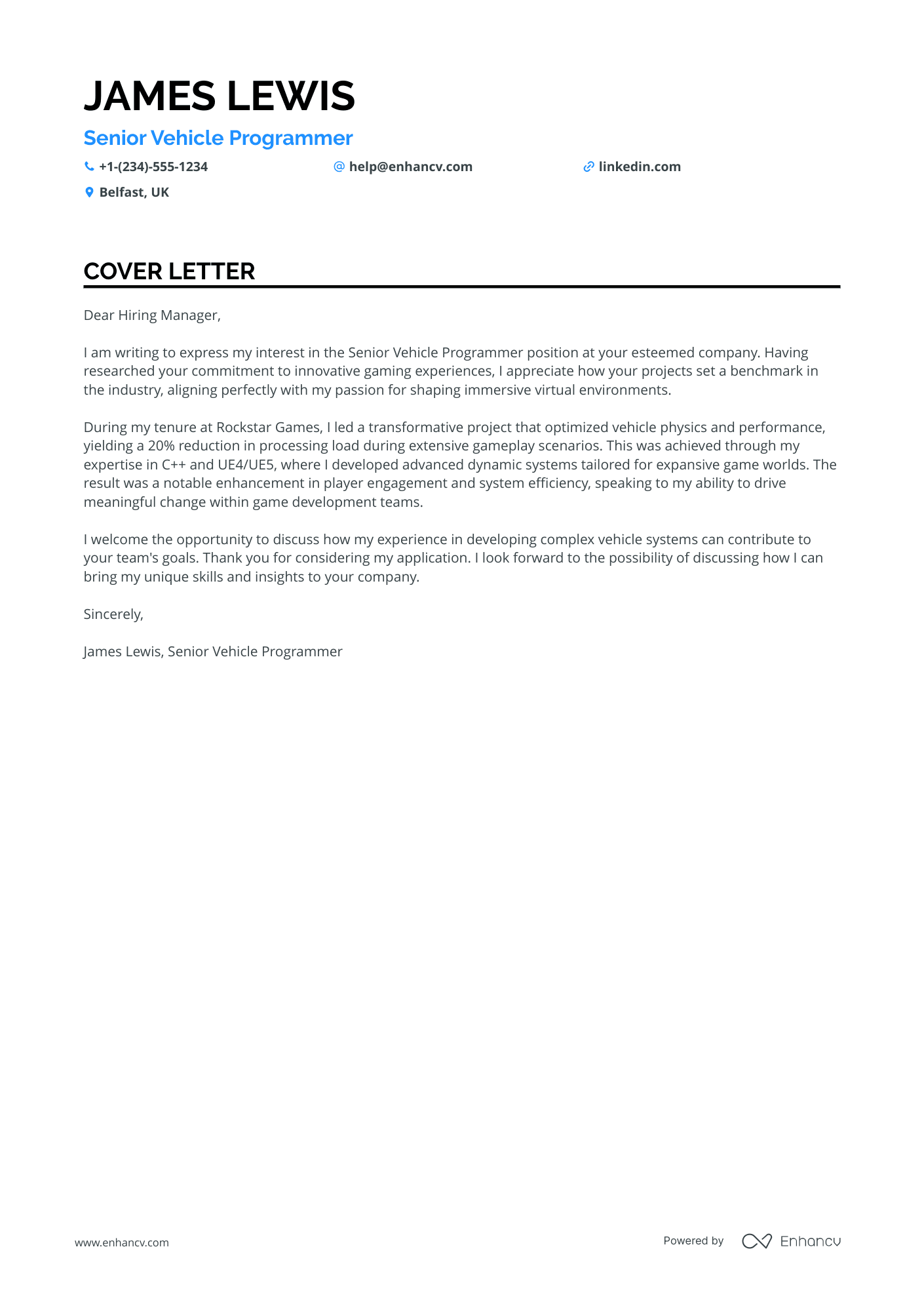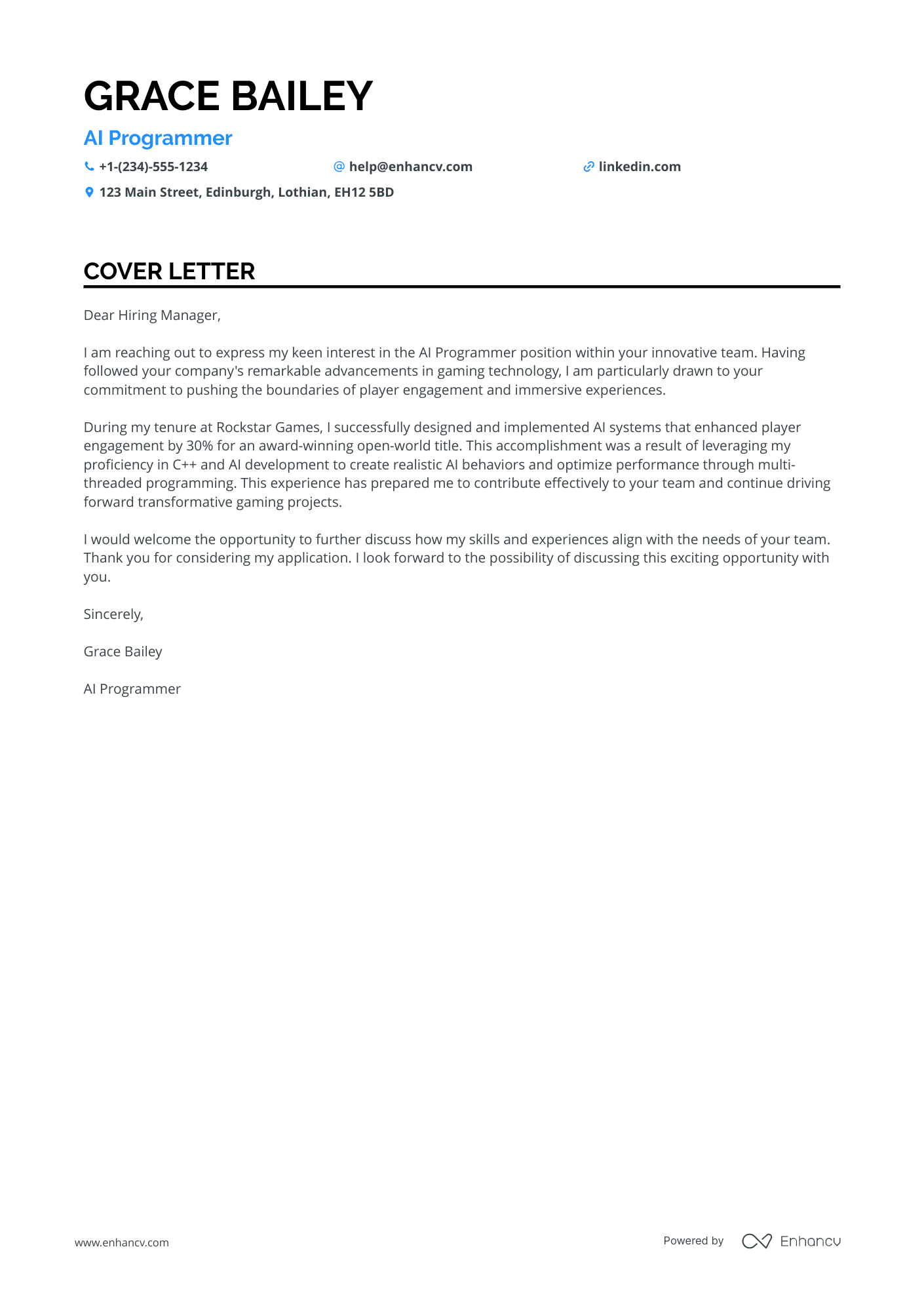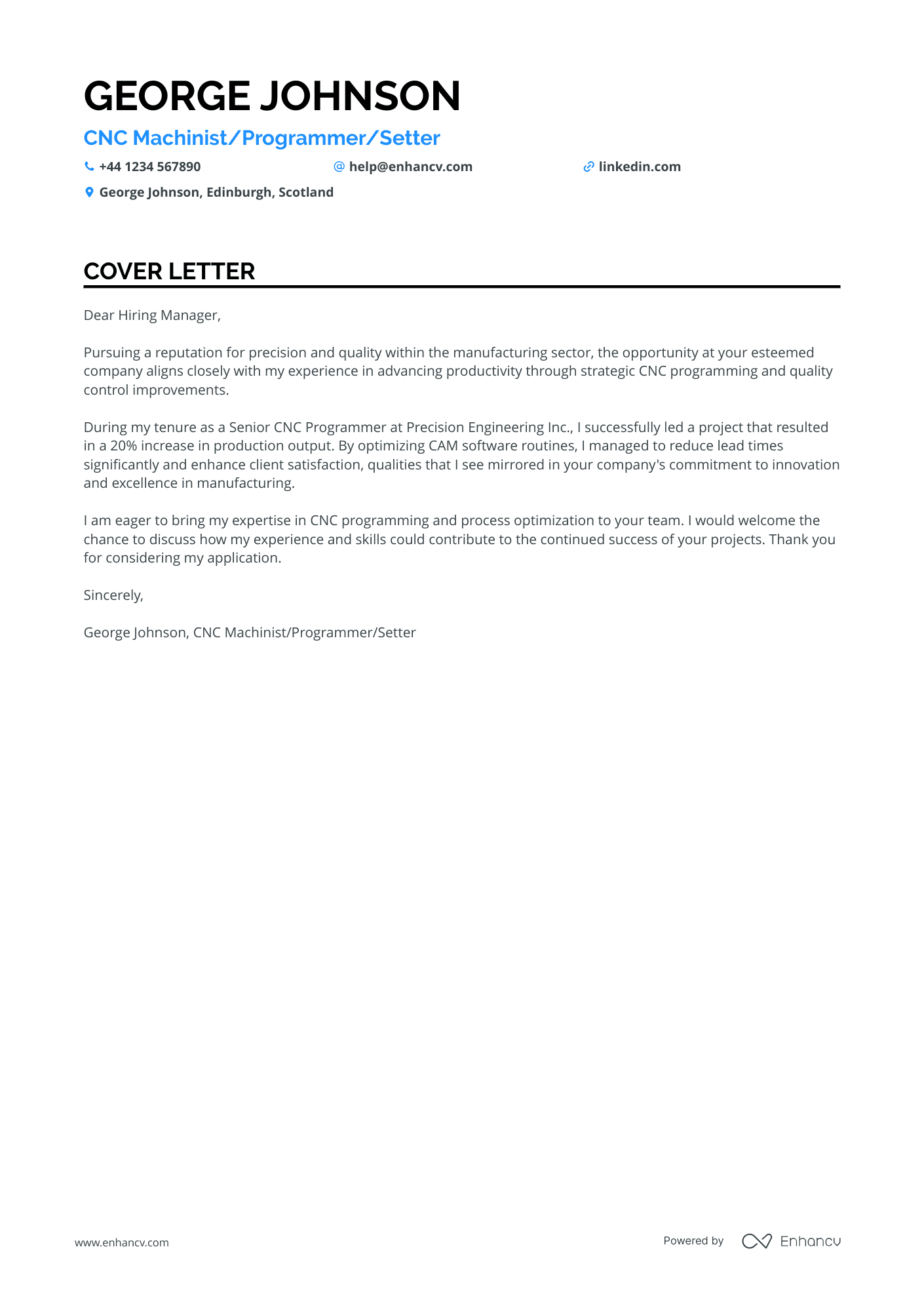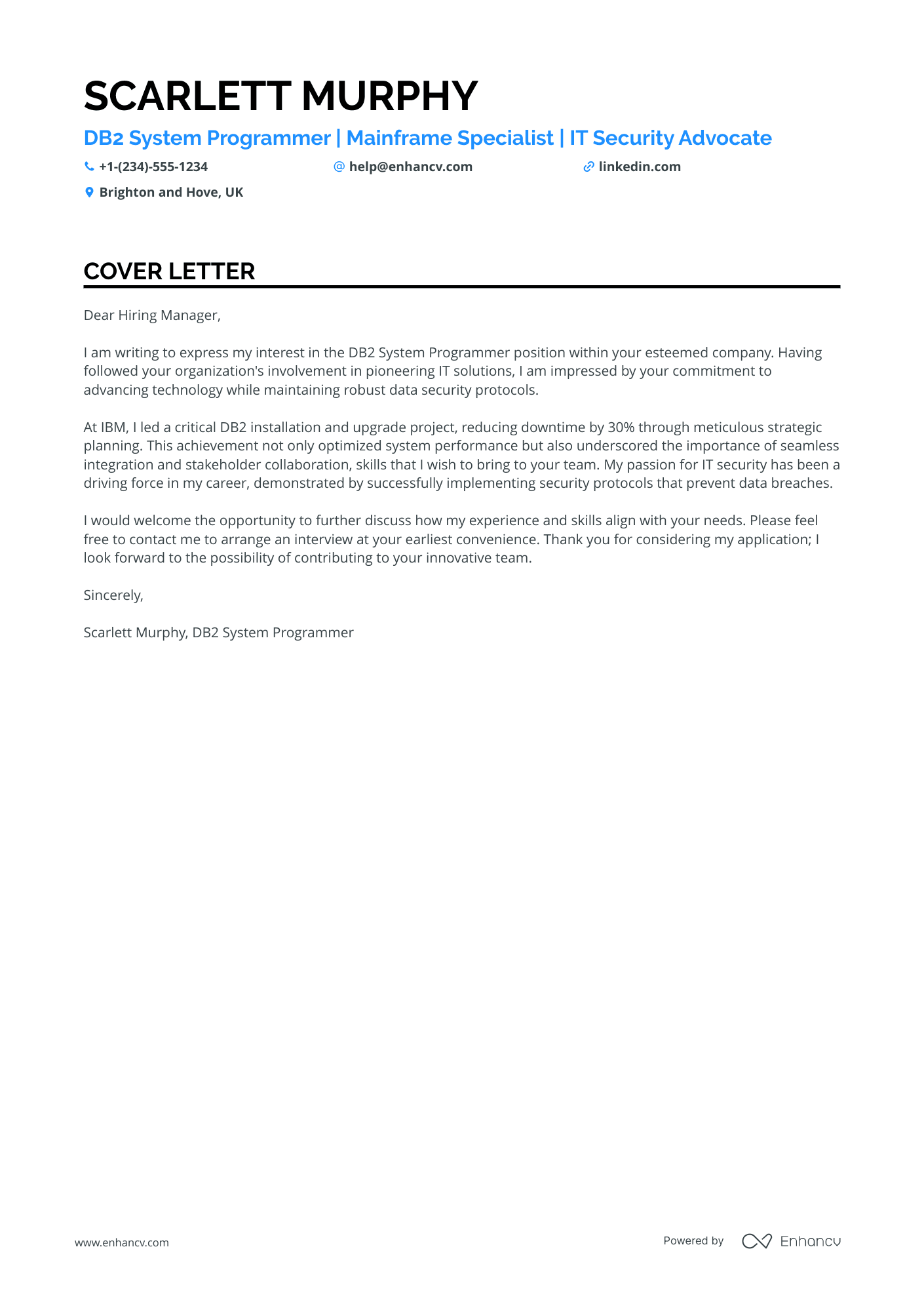Writing a strong cover letter requires close attention to detail, from the tone of voice to avoiding those pesky spelling or grammar mistakes.
Overlooking similar small details can weaken your application.
Many candidates also struggle with how to address the letter, often opting for 'Dear Sir or Madam' when they can’t find the correct contact. This can make your cover letter feel impersonal.
In this guide, we’ll show you how to perfect these crucial elements, ensuring your cover letter is polished and professional without relying on clichés.
Cover letter examples for programmer
By Experience
Junior Programmer
- Highlighting the Frontend Developer position at Geomatic Solutions is crucial, as it showcases current and relevant experience in improving website functionality and user engagement.
- Emphasising the Advanced skills in data structures and software design, demonstrating a specialised proficiency that can be particularly valuable in frontend development.
- Including certifications such as "Advanced JavaScript" from Udacity highlights a commitment to continuous learning and expertise in key programming areas.
- Mentioning the achievement of a 95% client satisfaction rate underscores strong project management abilities and client relationship skills, crucial for successful project delivery.
Senior Programmer
- Highlight Specific Skills: The cover letter effectively highlights James's expertise in Unreal Engine 4/5 and C++ Programming, which are critical skills for a Senior Vehicle Programmer role.
- Emphasise Leadership and Mentoring: Emphasising leadership experience, particularly mentoring junior developers, enhances the candidate's suitability for senior-level roles and demonstrates potential for team development.
- Provide Quantifiable Achievements: Including quantifiable achievements such as a "15% increase in player engagement" and "25% faster processing time" effectively showcases the candidate's ability to deliver tangible results.
- Showcase Industry Recognition: Highlighting contributions to award-winning projects at the BAFTA Games Awards effectively positions James as a contributor to highly recognised and successful industry projects.
By Role
Lead Programmer
- Emphasising Leadership Skills: The cover letter effectively highlights leadership capabilities, essential for a Lead Programmer, by showcasing experience in mentoring junior developers, conducting workshops, and enhancing team retention.
- Showcasing Technical Proficiency: Specific accomplishments in AI programming, code optimisation, and automated testing systems are emphasised, proving technical excellence crucial for game development roles.
- Demonstrating Cross-Departmental Collaboration: The ability to manage cross-departmental projects and streamline processes to improve efficiency and productivity is well documented, illustrating vital skills for leading complex projects.
- Highlighting Industry Recognition: Noting the development of award-winning games and successful launches provides evidence of high-level achievement and recognition in the industry, underpinning credibility.
Front-End Programmer
- Highlighting Quantifiable Outcomes: The cover letter effectively uses quantified achievements, such as increasing application performance by 25% and user engagement by 20%, to demonstrate the candidate's impact.
- Emphasising Relevant Experience: This cover letter details extensive experience with React, JavaScript, and API integration, aligning well with the role of a React/Java UX Front-End Programmer.
- Showcasing Leadership and Team Collaboration: The candidate mentions leading project teams and collaborating with cross-functional groups, which is important for roles requiring teamwork and leadership skills.
- Specific Skill Highlight: The mention of advanced skills in React and Redux, along with a course completion, reinforces the candidate's expertise in these key technologies.
Back-End Programmer
- Highlight Relevant Skills and Experiences: The cover letter effectively emphasises key skills such as full-stack development, back-end programming, and Unity3D expertise, which are crucial for a Full-Stack Developer role.
- Showcase Past Achievements: Describing specific accomplishments, such as leading a team to improve system performance by 25% at Electronic Arts, provides concrete evidence of the candidate's capability and impact.
- Mention Relevant Certifications and Courses: Including courses like "Advanced Unity3D Development" and "CNC Milling Mastery" showcases a commitment to ongoing learning and development, which is appealing to potential employers.
- Incorporate Quantitative Impact: Using metrics such as a 15% increase in game uptime and a 30% improvement in junior developers' coding efficiency gives credibility to the candidate's contributions.
Full-Stack Programmer
- Highlighting the candidate's achievement in launching a dynamic web application that improved user retention rates by 25% over six months, which emphasises their impact as a Full Stack Developer.
- Mentioning the Full Stack Web Development Specialisation course from The Hong Kong University of Science and Technology underscores a strong foundation in client-server communication and database design, vital for technical roles.
- Showcasing achievements in streamlining technical support processes with a 50% reduction in unresolved technical support tickets, demonstrating problem-solving skills and increasing efficiency.
- Emphasising mentoring junior developers, leading to faster project delivery, illustrates leadership abilities and a commitment to collaboration and team growth.
By Industry
Game Programmer
- Highlight the role's specialised leadership skills by showcasing experience in guiding cross-functional teams and improving workflow efficiency by 30%.
- Emphasise the technical prowess with achievements in game engine optimisation, leading to improved gameplay stability, performance, and increased downloads.
- Showcase proficiency in user-centred design through effective integration of player feedback, resulting in elevated player satisfaction scores by 40%.
- Include advanced educational qualifications, such as a MSc in Computer Science, which underscores a strong foundation in technical and theoretical knowledge of game development.
Systems Programmer
- Emphasise specific technical skills such as DB2 Installation and Maintenance, Mainframe Programming, and IT Security Protocols, as they align directly with the role of a DB2 System Programmer.
- Showcase a proven track record by detailing quantifiable achievements, for example, implementing solutions that reduced downtime by 30% or increased performance by 40%.
- Highlight professional accomplishments and recognition, such as receiving the Efficiency Optimisation Award or Innovation in IT Project Management, to demonstrate capability and leadership in the field.
- Include relevant certifications or courses like "Advanced DB2 Database Administration" and "Cybersecurity for IT Professionals" to underline advanced knowledge and commitment to continuous learning.
Web Programmer
- Highlighting Relevant Experience: The cover letter effectively showcases relevant experience, such as leading web application development at Codemasters, enhancing team collaboration and user engagement through innovative design and performance optimisation - essential for roles in AAA game development.
- Emphasising Technical Skills: It details proficiency in crucial programming languages and tools like PHP, JavaScript, React, and Docker, highlighting ability to build scalable and efficient systems critical for web programming and UX design in the gaming industry.
- Showcasing Leadership and Mentoring: The candidate demonstrates leadership skills through mentoring junior developers and leading cross-departmental projects, which is valuable for positions that require guiding teams and driving project success.
- Detailing Achievements and Impact: By outlining quantifiable achievements, such as increasing user engagement by 25% and reducing deployment time by 50%, the letter effectively communicates candidate's impact and value to potential employers.
Database Programmer
- Highlighting Good Clinical Practice (GCP): Mention of GCP compliance and results, such as maintaining a 95% audit compliance score and ensuring a key role in adhering to standards, is crucial for clinical data roles.
- Emphasis on Achievements in Data Integrity: Demonstrating the reduction of error rates and improvements in database integrity, such as a 30% error reduction at AstraZeneca, significantly reinforces the candidate's expertise in managing complex data operations.
- Focusing on Advanced Certifications: Inclusion of certifications like Advanced SQL for Clinical Data Professionals enriches the candidate's profile, highlighting their investment in continuous learning and up-to-date technical knowledge.
- Showcasing Collaborative Skills: Illustrating collaborative achievements, such as driving data testing improvements with cross-functional teams, showcases the candidate's ability to enhance system accuracy and reliability through teamwork.
Application Programmer
- Highlighting Relevant Experience: The cover letter effectively details over 5 years of experience in software development, showcasing leadership skills and efficiency improvements in prior roles, which are crucial for an Application Programmer role.
- Emphasising Key Achievements: The letter prominently features specific accomplishments such as improving application processing speed by 25% and reducing manual workload by 40% through automation, demonstrating a key aspect of the candidate's effectiveness.
- Showcasing Technical Skills: It lists important technical skills such as Java, Python, and SQL, along with proficiency in agile methodologies, which are well-aligned with the demands of a software development role.
- Linking Certifications to Skills: The cover letter effectively draws attention to relevant certifications in Database Management Systems and Advanced Java Programming, which enhance the credibility and depth of the candidate’s skill set.
Network Programmer
- Specific Expertise Highlight: Clearly emphasising expertise in C++ and multi-threaded programming, critical skills for a Network Programmer role.
- Impact Metrics Provided: Using specific figures to portray achievements, such as "20% decrease in online gameplay bugs," effectively shows the candidate's impact in previous roles.
- Diverse Experience Evidenced: Listing experiences from top gaming companies (Rockstar Games, Ubisoft, EA Games) demonstrates a robust background in online game development.
- Role-specific Achievements Mentioned: Highlighting role-related awards like "Network Performance Excellence Award" focuses on recognised competence in network programming.
Embedded Systems Programmer
- Highlight Relevant Experience: Emily effectively details her experience in embedded systems, showcasing specific achievements such as enhancing system efficiency by 30% at ARM Ltd., which is crucial for employers seeking measurable results.
- Emphasise Industry-Specific Skills: The cover letter outlines Emily’s proficiency in C/C++ programming and embedded systems, aligning perfectly with the technical requirements of an embedded systems programmer role.
- Include Education and Courses: Emily mentions her academic qualifications, including a Master of Science in Computer Engineering from a prestigious university. She also lists relevant courses like "Embedded Systems Design Specialisation," demonstrating her commitment to ongoing learning.
- Showcase Achievements and Projects: Emily includes specific projects and achievements, such as leading a project team to improve user satisfaction by 50%, providing tangible examples of her leadership and impact within the field.
Software Programmer
- Highlighting proficiency in programming languages such as C++ and Java, which are crucial for software development roles.
- Emphasising experience in key industry projects and achievements, such as developing a real-time monitoring system and reducing system responsiveness, to demonstrate practical and impactful contributions.
- Including a specific achievement of reducing energy costs by 15%, which may appeal to companies focused on energy efficiency.
- Demonstrating expertise in collaborative project environments, enhancing teamwork and communication skills, which are important qualities for roles requiring cross-functional interaction.
Mobile Application Programmer
- Highlight of Technical Skills: The cover letter effectively showcases key technical skills such as C#, SQL, and Objective-C, which are critical for a Mobile Application Developer role.
- Quantifiable Achievements: Numerous achievements are quantified, such as increasing transaction volume by 30% and improving data retrieval times by over 50%, providing tangible evidence of the candidate’s impact.
- Leadership and Team Management: The letter emphasises leadership capabilities, with examples of managing teams and projects, which is beneficial for senior roles or positions requiring collaboration and teamwork.
- Educational Background and Continuous Learning: Detailed education and additional courses demonstrate the candidate's strong foundational knowledge and commitment to staying updated in their field, vital for technological roles.
Graphics Programmer
- Emphasising specialised skills in graphics programming, such as proficiency in C/C++, HLSL, Direct3D, OpenGL, and Vulkan, which are crucial for a Graphics Programmer role.
- Highlighting quantitative achievements, such as delivering optimised solutions that improved rendering speeds by 30%, which showcases the candidate's ability to contribute significantly to performance improvements.
- Describing collaborative experiences, such as working with artists and designers to integrate new rendering features, demonstrating the candidate's ability to work effectively in a team-oriented environment.
- Showcasing leadership skills and mentoring experience, which are valuable for a Senior Graphics Programmer position, such as fostering a learning environment that increased team productivity by 30%.
AI Programmer
- Emphasise relevant experience in AI development, such as implementing systems that enhance player engagement and improve gameplay fluidity, to demonstrate a strong track record in the gaming industry.
- Highlight significant achievements, such as contributing to award-winning games and receiving accolades for AI innovation, to showcase the impact and recognition of previous contributions.
- Detail collaboration skills by describing work with cross-disciplinary teams to create realistic AI agents and game environments, underscoring the ability to work effectively with various professionals.
- List advanced skills in C++, 3D mathematics, and multi-threaded programming, affirming technical expertise that is crucial for an AI Programmer role.
Security Programmer
- Highlight the Certified Information Systems Security Professional (CISSP) certification to emphasise advanced knowledge in security management and operational best practices, essential for an IT Security Programmer role.
- Underline project management skills and experiences, such as leading a team to integrate security applications at BT Group, to demonstrate the ability to deliver large-scale, time-sensitive projects efficiently.
- Showcase a track record in enhancing system access processes and problem resolution, emphasising a commitment to operational efficiency and proactive incident handling.
- Mention the passion for cybersecurity innovations to convey dedication to staying ahead of emerging threats and solutions, aligning with the forward-thinking demands of the role.
Cloud Programmer
- Highlighting achievements such as optimising cloud solutions and reducing time-to-market by 35% can demonstrate the candidate's ability to deliver impactful results in cloud-based projects.
- Mentioning leadership roles, like leading a team to implement cloud-based architecture on Azure, showcases both technical expertise and the ability to manage and mentor others effectively.
- Emphasising specialised certifications such as AWS Certified Solutions Architect and Azure Architecture Design can support the candidate's proficiency in handling complex cloud infrastructures.
- Discussing the implementation of cross-platform integration and predictive analytics technologies illustrates the candidate's commitment to innovation and system improvement.
Mainframe Programmer
- Highlighting Technical Expertise: Mention of proficiency in Assembler language and achievements in optimising systems, which are crucial skills for a Mainframe Developer role.
- Emphasising Leadership Qualities: Experience in leading teams and mentoring junior programmers demonstrates leadership and team management skills, significant for senior-level positions.
- Document Management Skills: Detailing experience in crafting and optimising technical documents for compliance and accessibility shows attention to detail and the ability to communicate complex information effectively.
- Quantifying Impact: Specific metrics like "30% increase in system efficiency" or "20% decrease in operational costs" provide tangible evidence of the candidate's contributions and impact on past projects.
Programmer cover letter example
George Johnson
George Johnson, Edinburgh, Scotland
+44 1234 567890
help@enhancv.com
- Highlighting significant accomplishments, such as leading projects that increased production output by a specific percentage, demonstrates the ability to make impactful contributions.
- Emphasizing specific skills like optimizing CAM software routines showcases technical expertise critical for CNC programming roles.
- Aligning personal career goals with the company's values and objectives helps convey a tailored fit for the position and the company culture.
- Expressing eagerness to discuss further shows initiative and a proactive approach in seeking out opportunities for collaboration.
Importance of cover letters in the United Kingdom
Cover letters provide recruiters with the opportunity to learn more about your career aspirations, hinting at how you’d integrate within the organisation over the long term.
Here are three additional reasons why cover letters are important:
- Making an excellent first impression (and a formal introduction): Your cover letter is often the employer’s first introduction to you, showcasing your personality, communication skills, and motivation for the role.
- Complementing your career history: While your CV lists qualifications and experience, a cover letter provides the context, explaining how your background fits the role.
- Demonstrates your genuine interest: A well-crafted cover letter reflects the effort you’ve put into researching the company and role as well as your attention to detail.
What UK employers expect from a cover letter
A great cover letter can set you apart when applying for jobs in the UK.
Follow these tips to ensure you make a strong impression:
- Research thoroughly: Spend time delving into the company’s website, social media, and industry news to understand their projects, awards, and future plans. The more specific your knowledge, the better you’ll be able to demonstrate your suitability for the role.
- Reflect their values: Every UK company has its own set of values that guides their culture. Once you’ve identified them, make sure your cover letter reflects how your values and work ethic align with theirs. If they’re known for integrity, emphasise your commitment to ethical practices.
- Tailor your skills: Focus on aligning your most relevant skills with the job description. Look for key terms and priorities mentioned in the advert, and make sure to provide examples of how you excel in those areas.
How to format a programmer cover letter
Keep in mind that your cover letter is intended for the recruiters' eyes only, not for the Applicant Tracking Systems (ATS) software that aligns your job application with role requirements. That's why it's essential to concentrate on the quality of the content and presentation to make a memorable first impression.
Don’t forget to include:
- Your address and contact details
- The employer’s name and address
- Date
- Greeting
- Introductory paragraph
- Body paragraphs
- Closing paragraph
- Sign-off and signature
Now for some formatting tips and tricks: choose modern fonts such as Rubik, Volkhov, or Raleway instead of traditional ones like Arial. Keep your cover letter single-spaced with margins of around 1-inch (2.5 cm). To maintain a professional and consistent look, ensure that both your CV and cover letter use the same font style.
Lastly, always send your cover letter as a PDF to preserve its formatting and prevent any edits once it's sent, ensuring your design and layout remain intact for the recruiters.
How to write your programmer cover letter salutation
Imagine you're a hiring manager reading through countless cover letters—which would catch your attention: being addressed directly by name, or reading 'Dear Sir or Madam'?
The first option shows you've made the effort to learn about the company and the role.
To find the hiring manager's name, try LinkedIn, check the company's website, or even reach out to the organisation on social media.
How to write your programmer cover letter intro
One of the best ways to grab a hiring manager's attention? Show them the unique value you'd add to the team.
Review the skills or requirements listed in the posting and draw connections to your previous work experiences.
Focus on specific (and quantifiable) accomplishments and qualifications that align with the job description to make a strong first impression.
How to write your programmer cover letter body
Your cover letter body is the most spacious and vital part of this document—it highlights your true value and the impact you can bring as a candidate.
Remember, your cover letter serves a different purpose to your CV. Here, you need to show your skills in context by telling the story of one significant achievement, hinting at how you’ll help your future employer achieve their goals.
So, when writing your cover letter body:
- Use concrete achievements to demonstrate your personality and impact.
- Support your achievements with quantifiable data and metrics.
- Tell the story of a successful project you’ve worked on and explain how you contributed to the outcome.
- Highlight both hard and soft skills to make your story more engaging.
- Focus on skills that are most relevant to the role and align with the company’s needs.
How to write a closing paragraph
Now we’ve reached the closing paragraph of your cover letter. You might be tempted to end with a simple Yours sincerely, but don’t!
Instead, finish with a promise to enhance the company’s performance metrics (backed by your hard and soft skills), to develop as a professional, or something else that holds significance for the organisation. Whatever you choose, ensure to stand behind your words and be remain sincere.
Don’t forget to include a call to action, encouraging recruiters to suggest the best time to follow up for an interview or update.
Conclusion
Creating a compelling cover letter is vital in making a positive first impression on potential employers. Personalise your letter by addressing the hiring manager directly and ensuring your skills align with the job description.
Highlight specific achievements that demonstrate your suitability for the role, and express genuine enthusiasm for the opportunity. Finally, maintain a professional format that complements your CV for a cohesive application.












































